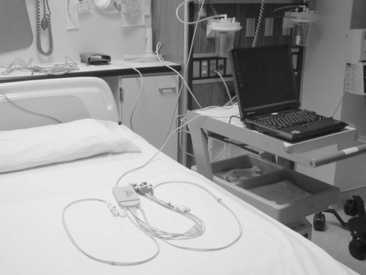PROCEDURE 60 A 12-lead electrocardiogram provides information about the electrical system of the heart from 12 different views or leads. The electrocardiogram is the most commonly conducted cardiovascular diagnostic procedure.3 Common uses of a 12-lead electrocardiogram include diagnosis of acute coronary syndromes, identification of dysrhythmias and conduction disturbances, and determination of the effects of medications or electrolytes on the electrical system of the heart. • Understanding of the anatomy and physiology of the cardiovascular system, principles of cardiac conduction, the cardiac cycle, properties of cardiac tissue (automaticity, excitability, conductivity, and refractoriness), principles of electrophysiology, electrocardiographic (ECG) lead placement, basic dysrhythmia interpretation, and electrical safety is necessary. • Advanced cardiac life support knowledge and skills are needed. • Clinical and technical competence in the use of the 12-lead ECG machine and recorder is necessary. • A 12-lead ECG provides different views or leads of the electrical activity of the heart. The leads are standard limb leads (I, II, III), augmented limb leads (Augmented Vector Right or aVR, Augmented Vector Foot or aVF, and Augmented vector Left or aVL), and six chest leads (V1 to V6). • The standard and augmented leads view the heart from the vertical or frontal plane (Fig. 60-1), and the chest leads view the heart from the horizontal plane (Fig. 60-2). • The graphic display consists of the P, Q, R, S, and T waves, which represent electrical activity within the heart. • Serial 12-lead ECGs (more than two ECGs recorded at different times) may be obtained. The accuracy of interpretation relies on consistent electrode placement. Indelible markers can be used to identify the electrode locations to ensure that the same lead placement is used when serial ECGs are recorded. • Advances in technology have allowed for online or wireless transmission, networking capabilities, and computerized interpretation of the 12-lead ECG (Fig. 60-3). The 12-lead ECG cable is attached to a processing device that digitizes the 12-lead ECG recording and transfers the information to the wireless device, which transmits the information to the medical record. This increases access to the 12-lead ECG for review and can assist with rapid interpretation and treatment of the patient. • 12-lead ECG machine and recorder • Gauze pads or terrycloth washcloth • Cleansing pads or nonemollient soap and water • Patient cable and lead wires Additional equipment to have available as needed includes the following:
Twelve-Lead Electrocardiogram
PREREQUISITE NURSING KNOWLEDGE
EQUIPMENT
![]()
Stay updated, free articles. Join our Telegram channel

Full access? Get Clinical Tree


Anesthesia Key
Fastest Anesthesia & Intensive Care & Emergency Medicine Insight Engine



